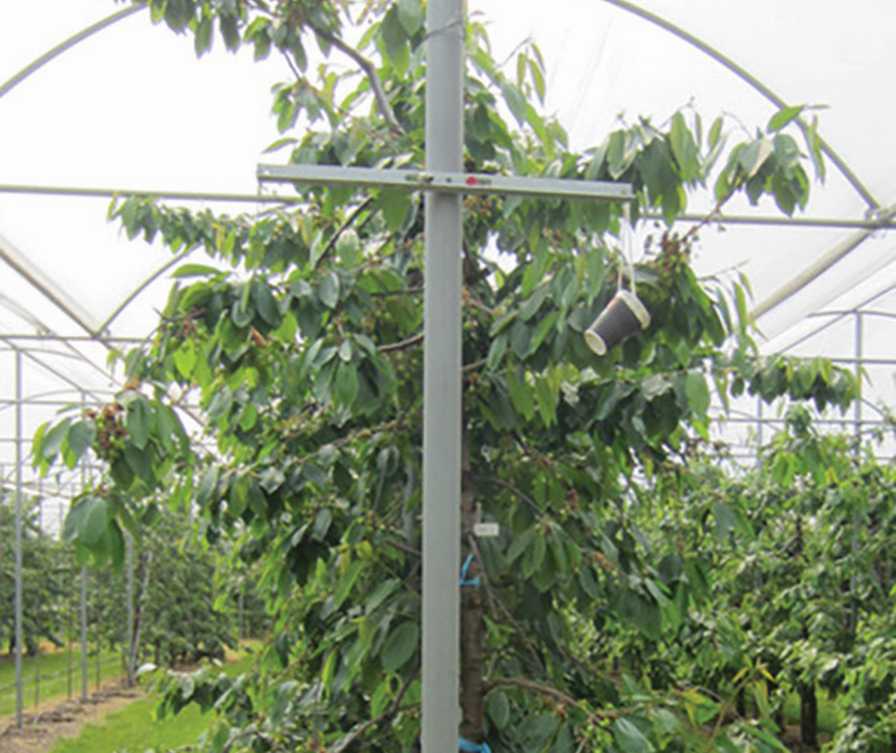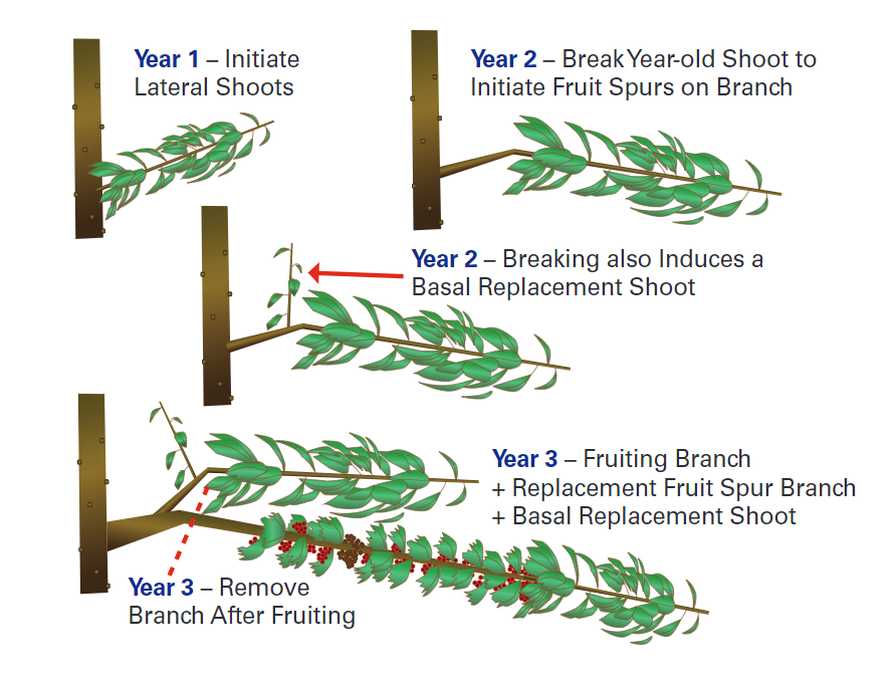#Recipe #Foody

A double-T trellis for supporting the two “table tops” of broken, fruit-bearing branches.
Photo by Gregory Lang
In recent articles, I have stressed the importance of renewal pruning to sustain sweet cherry fruit quality and yield over the life of the orchard. Renewal pruning approaches range from selective annual regeneration of the largest one to three fruitwood structures — such as branches or vertical leaders in tall spindle axe (TSA) and Kym Green bush (KGB) training, respectively — to annual regeneration of all fruitwood structures (such as stub-pruning of every lateral shoot in super spindle axe (SSA) training) to periodic renewal of the entire tree (whole tree renewal, applicable to upright fruiting offshoots (UFO), KGB, and even TSA trees).
Another creative strategy has been developed in the Netherlands for high-density orchards. This is known as Table Top (TTP), or Sistema de Renovación Permanente (SRP, as introduced in Chile) training. Like SSA, every fruit-bearing branch is renewed every year; however, the TTP renewal process ultimately develops two-year-old branches with fruiting spurs rather than one-year-old shoots with basal non-spur flower buds. Consequently, each fruiting unit has a higher yield potential (more flower buds and more leaf area) than SSA, but this also means a more three-dimensional canopy rather than a planar fruiting wall like SSA or UFO. Also like SSA, this annual renewal of the fruit-bearing structure, after only one year of cropping, maintains a young population of fruiting sites with a relatively balanced leaf-to-fruit ratio and, therefore, crop load management is achieved entirely by pruning.
TTP training creates a central leader tree with two tiers, or table tops, of fruit-bearing branches, with a window of open canopy in between for good light distribution to the lower tier. A double-T trellis (3-foot-wide cross-arms) provides support for each table top (see Table Top Trellis photo). What is innovative is how these tiers are formed and how the two-year-old fruit spur-bearing shoots develop and recycle every three years.
TRAINING TABLE
Training begins with either a “feathered” nursery tree — if the lateral shoots are located just above the lower T-trellis wires — or with the initiation of lateral shoots on a whip nursery tree just above the T-wires. This initiation of laterals can be accomplished by treatment with plant growth regulators such as Promalin, scoring, bud selection and removal, or lightly scoring and cracking/breaking of the leader about 8 inches above the T-wires and re-tying it vertically to an upper wire to heal while the buds below the break elongate into shoots. In any case, six or more lateral shoots is desired.
At budbreak in year 2, a shallow saw cut scores the top of each lateral shoot just above an upper-oriented vegetative bud near the base of the shoot (4 to 6 inches from the leader). The shoot is then cracked/broken downward and fixed to the T-wire for support while it heals. This initiates a replacement shoot from the vegetative bud below the break and initiates spur formation beyond the break while reducing shoot extension vigor.

Year-by-year training for Table Top fruiting branch formation, renewal, and removal.
At budbreak in year 3, the previously broken shoot will be fruiting on spurs and basal flower buds of its reduced vigor extension growth. The new replacement shoot initiated in year 2 is scored above a basal vegetative bud, broken, and fixed to the T-wire to heal and develop the next generation of fruiting spurs while inducing a new replacement shoot. After harvest, the original fruiting branch is removed at the point of the original break. The cycle is now complete and is repeated every year, so the only permanent structure is the central leader and the basal stubs from which new replacement shoots arise. If new shoots arise from latent buds on the central leader or on branch stubs below old points of breakage, these can be trained similarly to replace the older stubs as they extend further from the leader.
BREAKING BRANCHES
Breaking each future fruiting branch will reduce its vigor as it forms fruit spurs, but if lateral shoots develop on the branch, remove them with thinning cuts to maintain a narrow fruiting branch. Never head the broken branch. The goal is to develop a continuous cycle of about six fruiting branches per tier, with an equal number of replacement branches that are forming future fruiting spurs, plus an equal number of new shoots that will become replacement branches. If any replacement branches are excessively vigorous, they can be scored and broken in late summer of the year they form, rather than in the spring. This also achieves more rapid healing and promotes less risk of bacterial canker infection. To further reduce risk of infection, precede or follow spring scoring and breaking with an application of an antibiotic.
The upper tier should be developed similarly. Prune back lateral shoots that arise from the central leader (in between the tiers) to the most basal vegetative bud (SSA-style). This promotes good light exposure throughout the lower tier while supplementing the fruiting population with basal non-spur fruiting sites. Also, thin excessive laterals entirely. When the tree reaches its mature height, the growth of the leader is slowed by breaking it, rather than imposing a heading cut, which also helps to reduce the stimulation of multiple vertical replacement shoots.
Greg has been our cherry expert since 2014. He conducts research to develop and integrate knowledge about new rootstocks, varieties, environmental and developmental physiology, and orchard technologies into optimized, efficient production systems. See all author stories here.
Recipe
via https://www.DMT.NEWS
Paul Rusnak, Khareem Sudlow
- Share:



0 comments